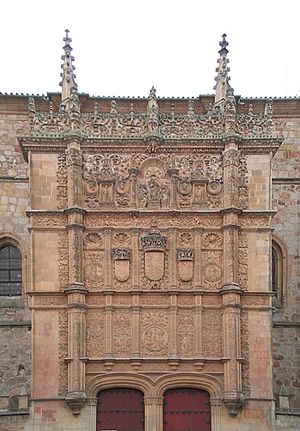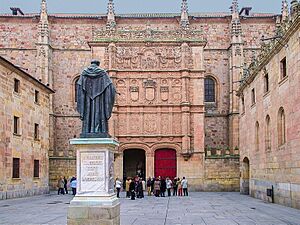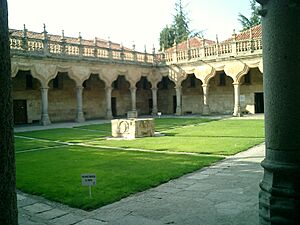University of Salamanca facts for kids
|
Universidad de Salamanca
|
|

Seal of the University of Salamanca
|
|
| Motto | Omnium scientiarum princeps Salmantica docet (Latin) |
|---|---|
|
Motto in English
|
Salamanca is foremost in teaching all the sciences |
| Type | Public |
| Established | 1218 |
|
Academic affiliations
|
EUA, Coimbra Group |
| Rector | Juan Manuel Corchado |
|
Academic staff
|
2,453 |
|
Administrative staff
|
1,252 |
| Students | 30.000 |
| 2,240 | |
| Location |
,
,
40°57′41″N 05°40′00″W / 40.96139°N 5.66667°W |
| Campus | Urban/College town |
| Colours | Carmine |
 |
|
| University rankings | |
|---|---|
| Global – Overall | |
| ARWU World | 501–600 (2023) |
| QS World | =534 (2024) |
| THE World | 801–1000 (2024) |
| USNWR Global | =770 (2023) |
The University of Salamanca (Spanish: Universidad de Salamanca) is a public research university located in Salamanca, Spain. It was founded in 1218 by King Alfonso IX. This makes it the oldest university in the Hispanic world (Spanish-speaking countries). It is also the fourth oldest university in the world that has been open continuously. Today, over 30,000 students from 50 different countries study here.
Contents
History of the University
Before the university was officially founded, there was a cathedral school in Salamanca. This school existed as early as 1130. King Alfonso IX of León started the university as a studium generale in 1218. A studium generale was a place where many different subjects were taught.
Later, in 1254, King Alfonso X set up rules for how the university should be run. He also provided money for it. In 1255, Pope Alexander IV officially recognized the university. This meant that degrees from Salamanca were accepted everywhere.
People used to say, "Quod natura non dat, Salmantica non praestat" (what nature does not give, Salamanca does not lend). They also said, "Multos et doctissimos Salmantica habet" (Salamanca has many very learned people). These sayings show how famous and respected the university quickly became.
During the time of King Ferdinand II of Aragon and Queen Isabella I of Castile, Spain's government changed a lot. The university played a big role in training "letrados." These were educated people, like lawyers and government workers. Many of them were graduates of Salamanca. They helped run the Spanish government, including its growing empire in the New World.
When Christopher Columbus was trying to get support for his voyage, he spoke with experts at the University of Salamanca. Even though some were doubtful, the university generally supported the idea of exploring unknown lands to the west. In the next century, the "School of Salamanca" debated important ideas. They discussed the fairness of colonization in the Americas. They also studied science, geography, cartography, economics, philosophy, and theology.
The university also had special places called Colegios Mayores (Major Colleges). These were first set up to help poor students attend the university. Over time, they became very powerful. Most of them were destroyed by Napoleon's troops much later. In the 1800s, the Spanish government closed the university's law and theology departments. These departments were later reopened in the 1940s as part of the Pontifical University of Salamanca.
University Achievements
The university's teachers helped improve the theology department. They also laid the groundwork for modern law and international law. They even contributed to modern economic science. The university was active in the Council of Trent, an important meeting for the Catholic Church.
Salamanca's mathematicians worked on the Gregorian calendar reform. This was asked for by Pope Gregory XIII. They proposed the solution that was eventually used. By 1580, about 6,500 new students came to Salamanca each year. Many graduates became important officials in the Spanish government.
It was also around this time that the first female university students likely attended. Beatriz Galindo and Luisa de Medrano were among them. Luisa de Medrano was probably the first woman ever to teach classes at a university.
Legends of Sorcery
In old stories, the university was sometimes linked to magic. There was a cave in Salamanca that people believed was a school for black magic. The name "Salamanca" itself can mean "cave" or "hand trick" in Spanish. The salamanquesa (a type of lizard) is also linked to magic in Spanish traditions.
In Romanian folklore, there's a legend about a school of black magic run by the devil. This school is called the Scholomance. Its name comes from "Salamanca" and the wise king "Solomon".
The University Today
The University of Salamanca attracts students from all over Spain and the world. It is a top choice for students coming from other regions of Spain. It is also very famous for its Spanish language courses for people learning Spanish. More than two thousand foreign students come each year just for these courses.
The university also does a lot of scientific research. It has research centers like the Cancer Research Centre and the Institute of Neuroscience. It also has a center for powerful lasers. The University of Salamanca is one of only two Spanish-speaking universities that work with the United Nations. They help train language experts for the UN. In 1989, the university also helped start the Association of Language Testers in Europe (ALTE) with the University of Cambridge.
In 2018, the university celebrated its 800th birthday!
Library
The university's library holds a very large collection of books. It has about 906,000 volumes.
Notable People
Many famous people have been part of the University of Salamanca, either as staff or students.
Notable Staff
- Juan de Galavís, professor of theology
- Francisco Elías de Tejada y Spínola, professor of Philosophy of Law
- Enrique Gil Robles, professor of Natural Law
- Pablo de Coronel (d.1534), professor of Hebrew
- Miguel de Unamuno, writer
- Beatriz Galindo, (d. 1534), professor of Latin and rhetoric
- Luisa de Medrano, (d. 1527) the first female professor at the University, teacher of Latin. A secondary school in Salamanca is named after her.
- García de Medrano y Álvarez de los Ríos (d. 1683) professor of Canon law
- García de Medrano y Mendizábal, rector of the University of Salamanca in 1669
- Juan Manuel Corchado, computer scientist and rector in 2024
Notable Students
- Miguel de Cervantes, author
- Luis de Góngora
- Fray Luis de León
- Francisco de Vitoria
- Pedro Calderón de la Barca
- Bartolomé de Las Casas
- Beatriz Galindo
- Miguel de Unamuno
- Bernardino de Sahagún
- Henry O'Neill
- Flora de Pablo
- Gustavo Petro, President of Colombia
- Roberto Urdaneta Arbeláez, President of Colombia
- Arístides Royo, President of Panama
- Francisco J. Ayala
- Susana Marcos Celestino
- Abraham Zacuto
- Ignacio Baleztena Ascárate
- Esteban de Bilbao Eguía
- Domingo de Soto
- Melchor Cano
- Francisco Suárez
- John of the Cross
- Antonio de Nebrija
- Gaspar de Guzmán, Count-Duke of Olivares
- Gaspar Sanz
- Pedro Gómez Labrador
- Cardinal Mazarin
- Mateo Alemán
- Diego de Torres Villarroel
- Pedro Salinas
- Adolfo Suárez
- Juan Zarate
- Manuel Belgrano
- Luis de Onís
- Pedro Nunes
- Simón de Rojas
- Antonio Tovar
- Gaspar Cervantes de Gaeta
- Xavier Becerra
- Ángela Abós Ballarín
- Juan Pizarro Navarrete
See also
 In Spanish: Universidad de Salamanca para niños
In Spanish: Universidad de Salamanca para niños
- School of Salamanca
- Pontifical University of Salamanca
- List of medieval universities
Literature
- Manuel Fernández Álvarez, Luis E. Rodríguez San Pedro & Julián Álvarez Villar, The University of Salamanca, Ediciones Universidad de Salamanca, 1992. ISBN: 84-7481-701-3.






